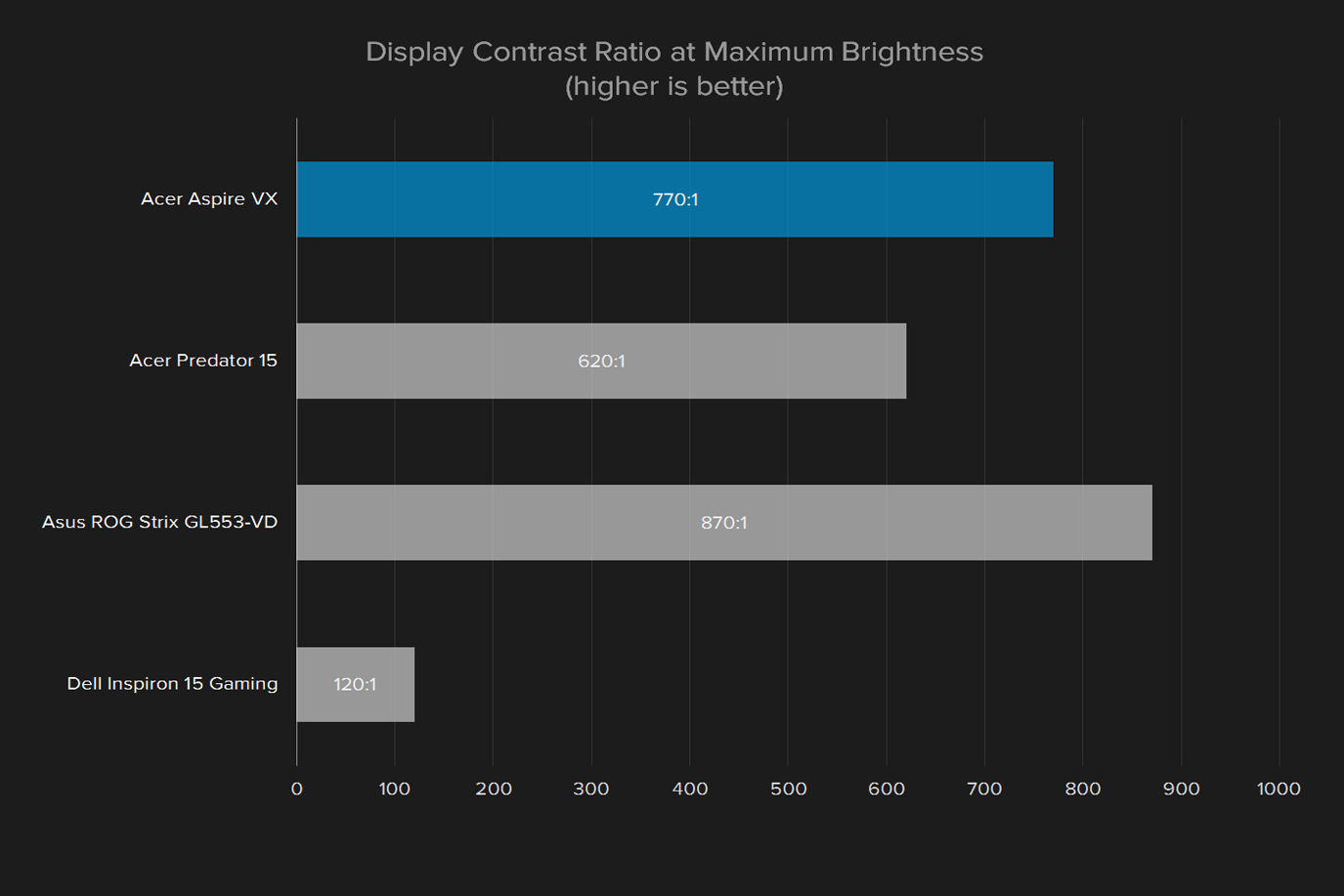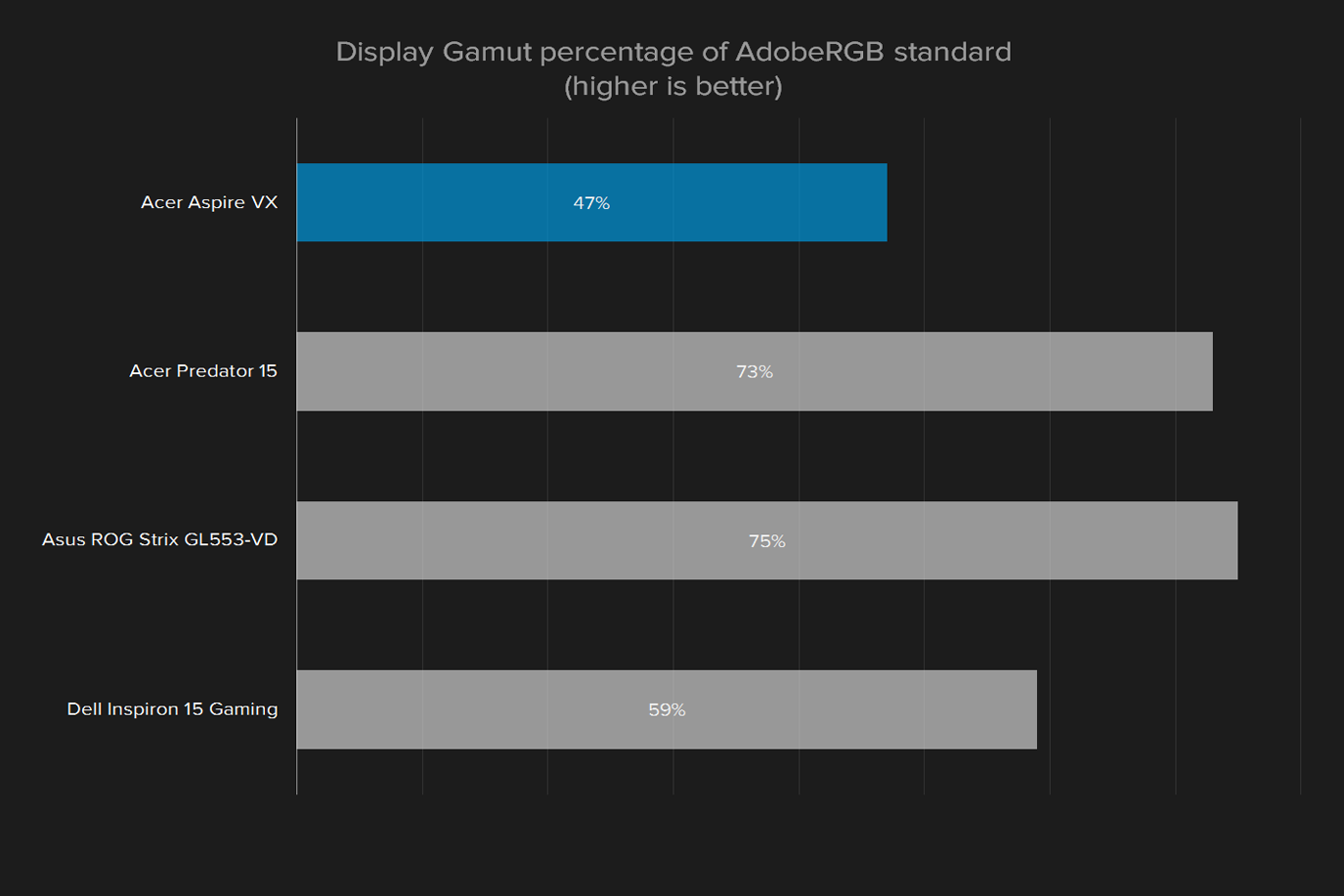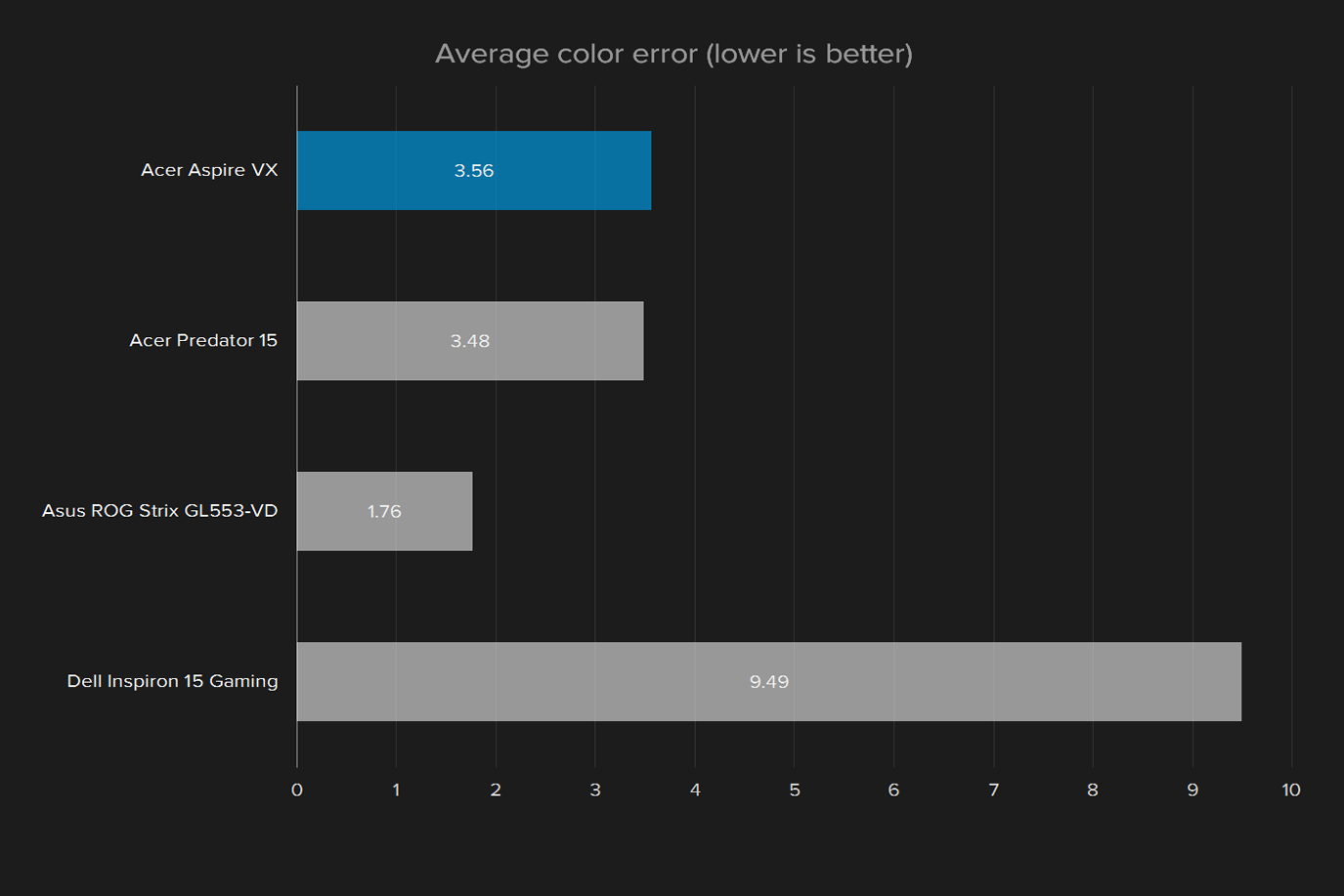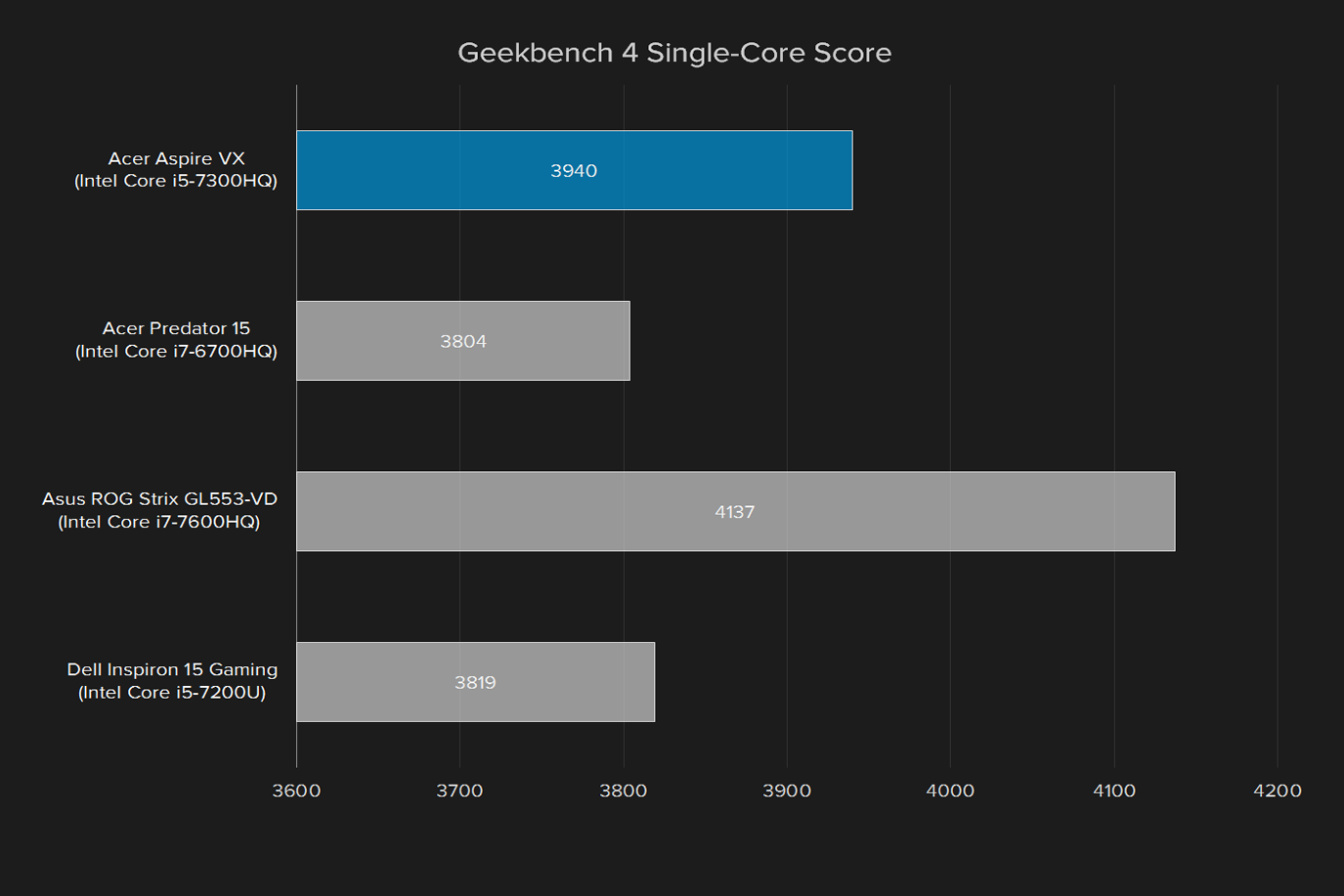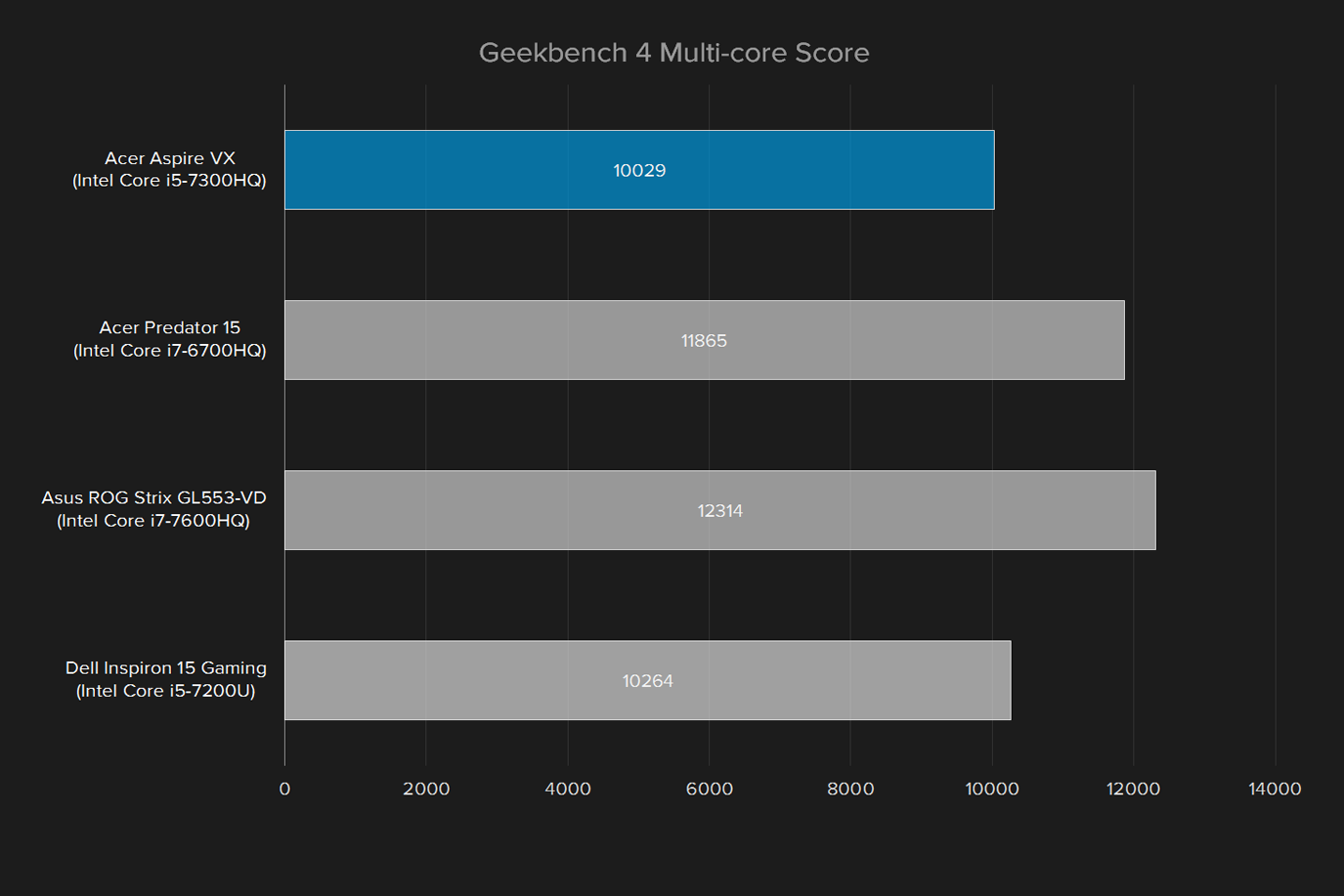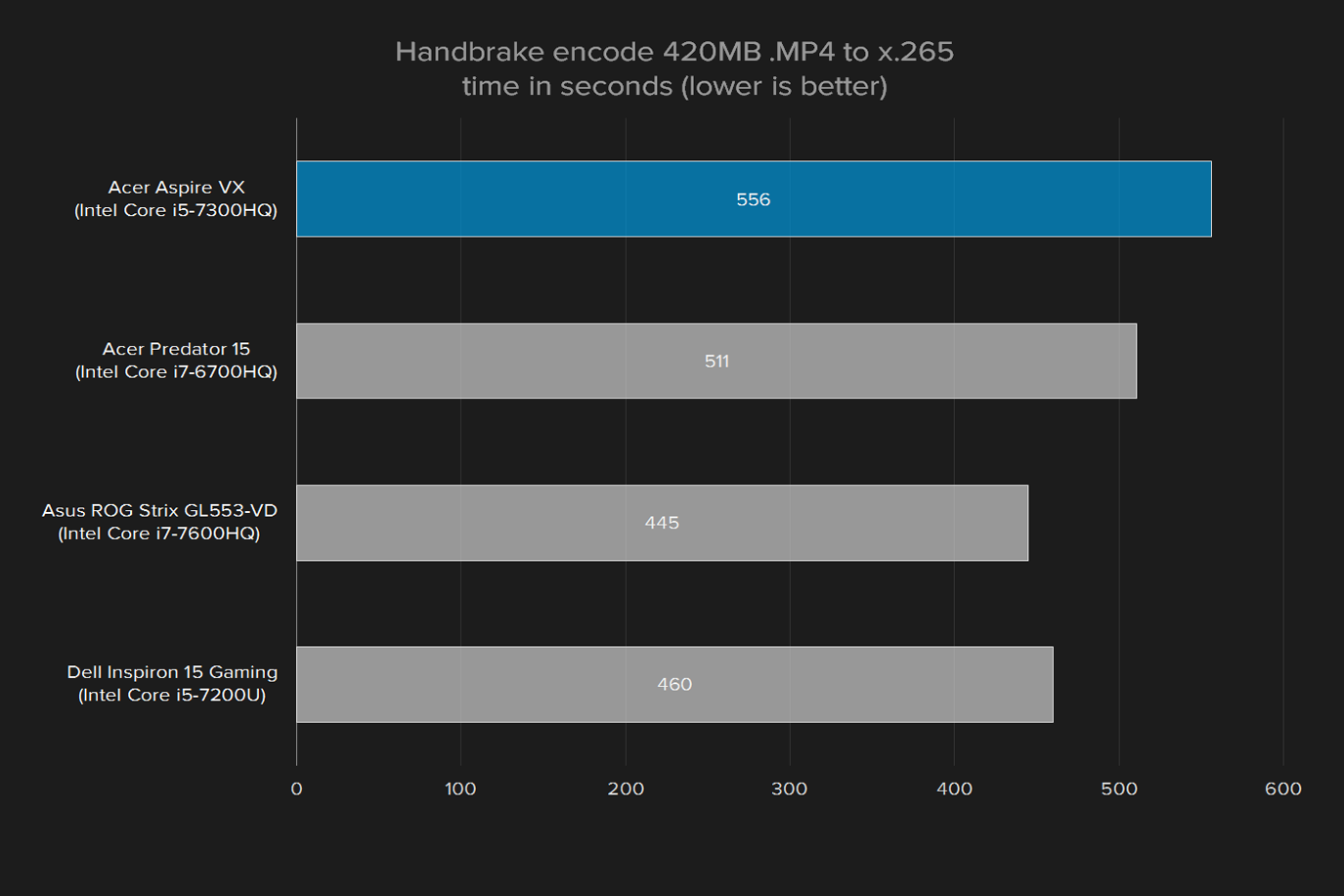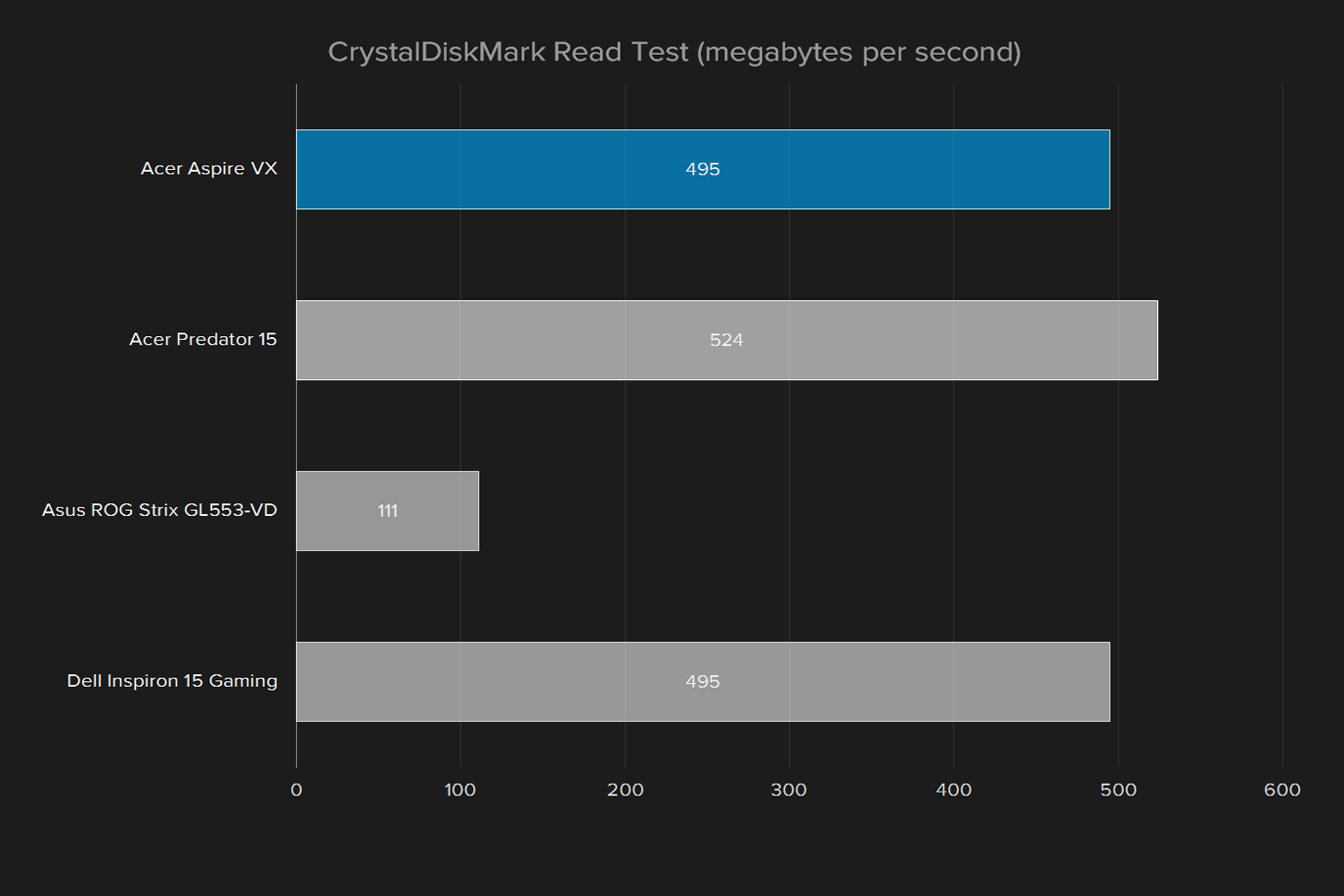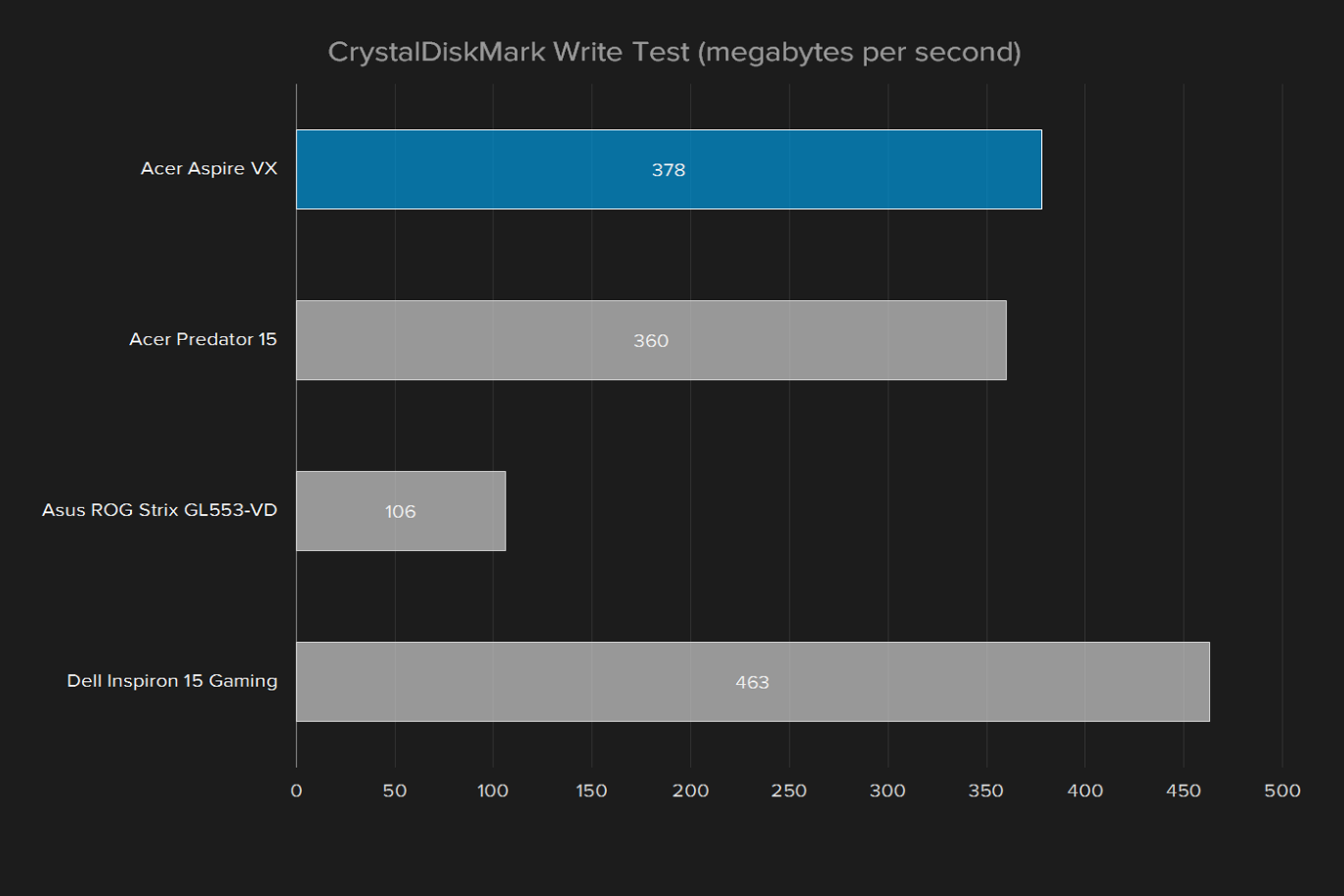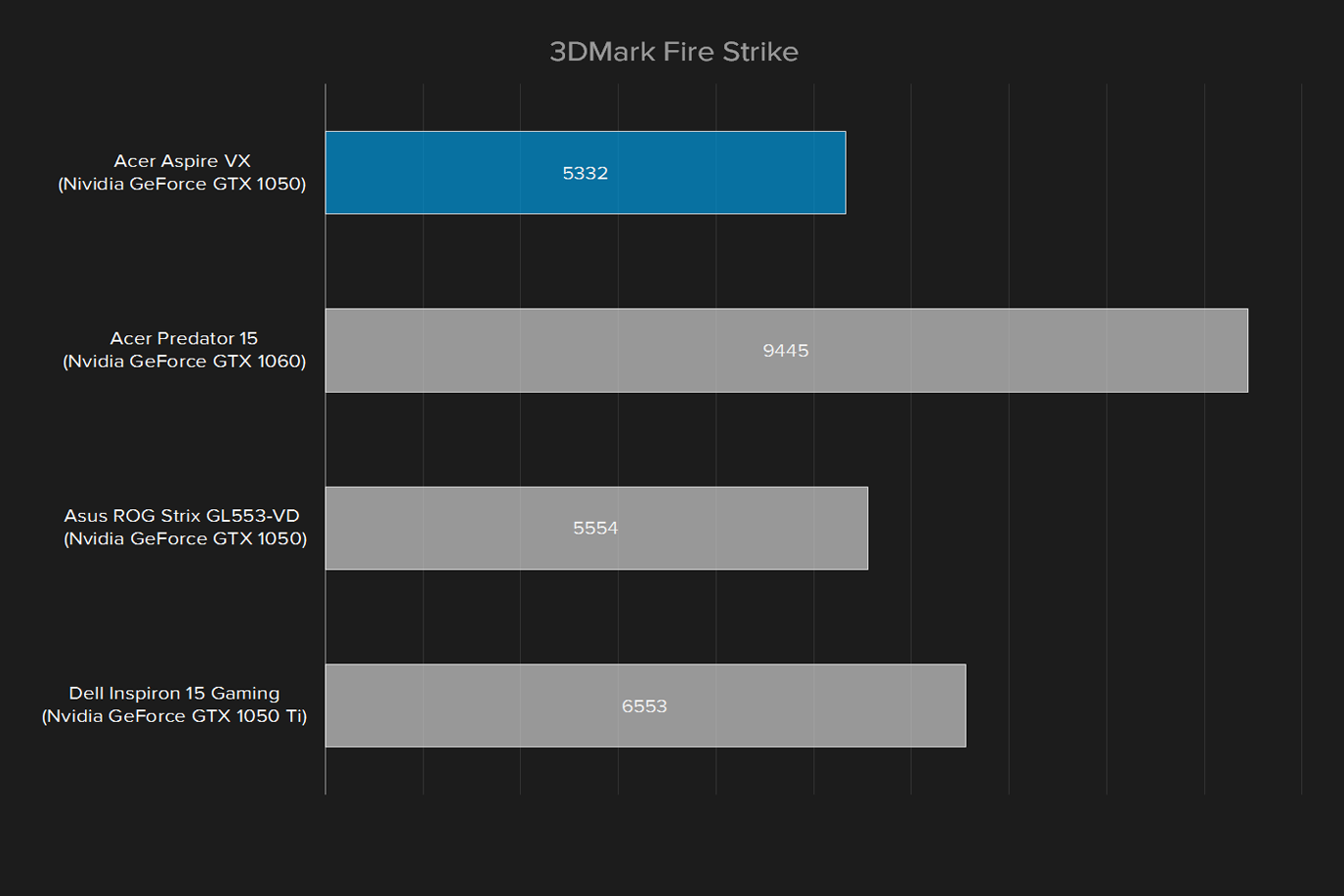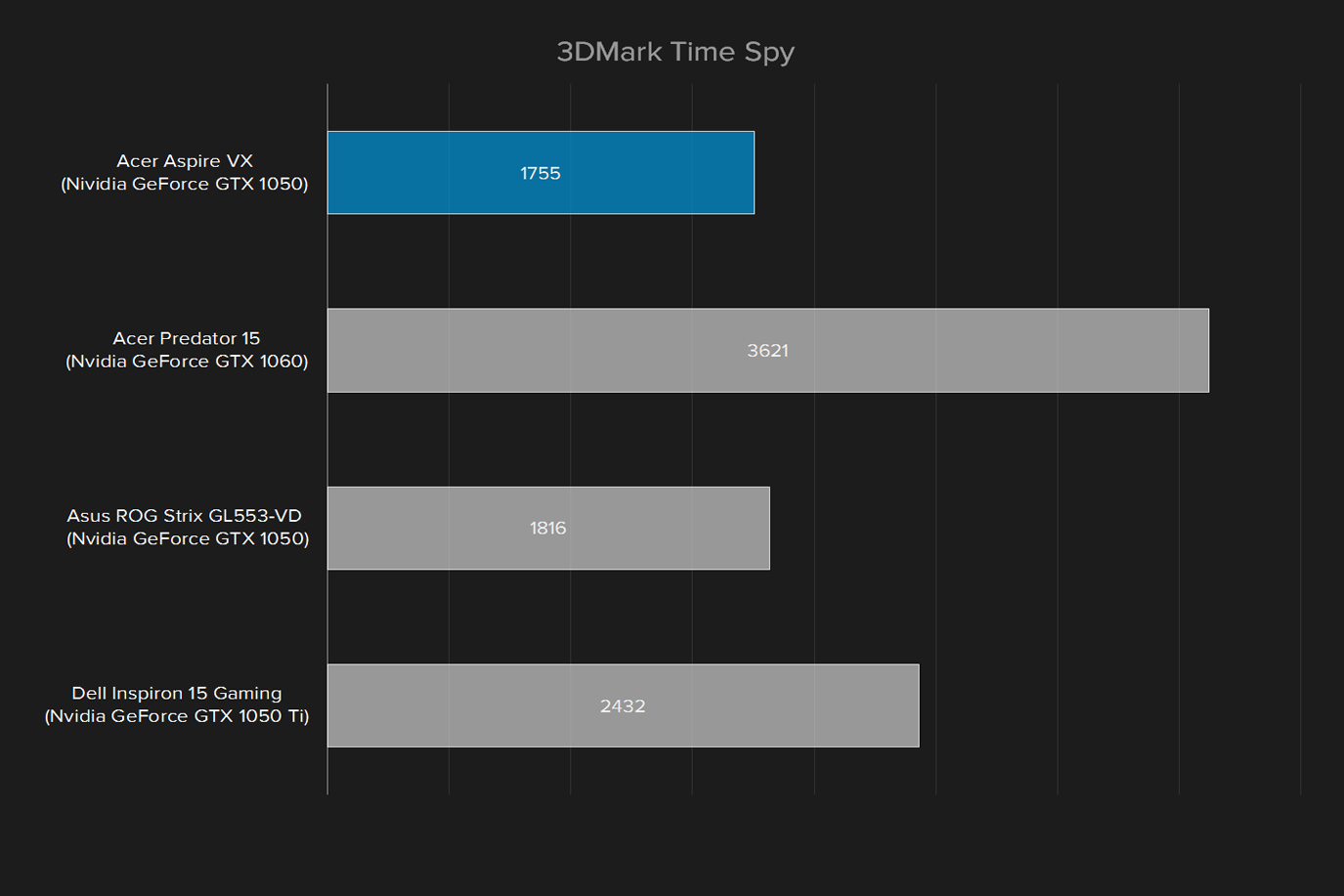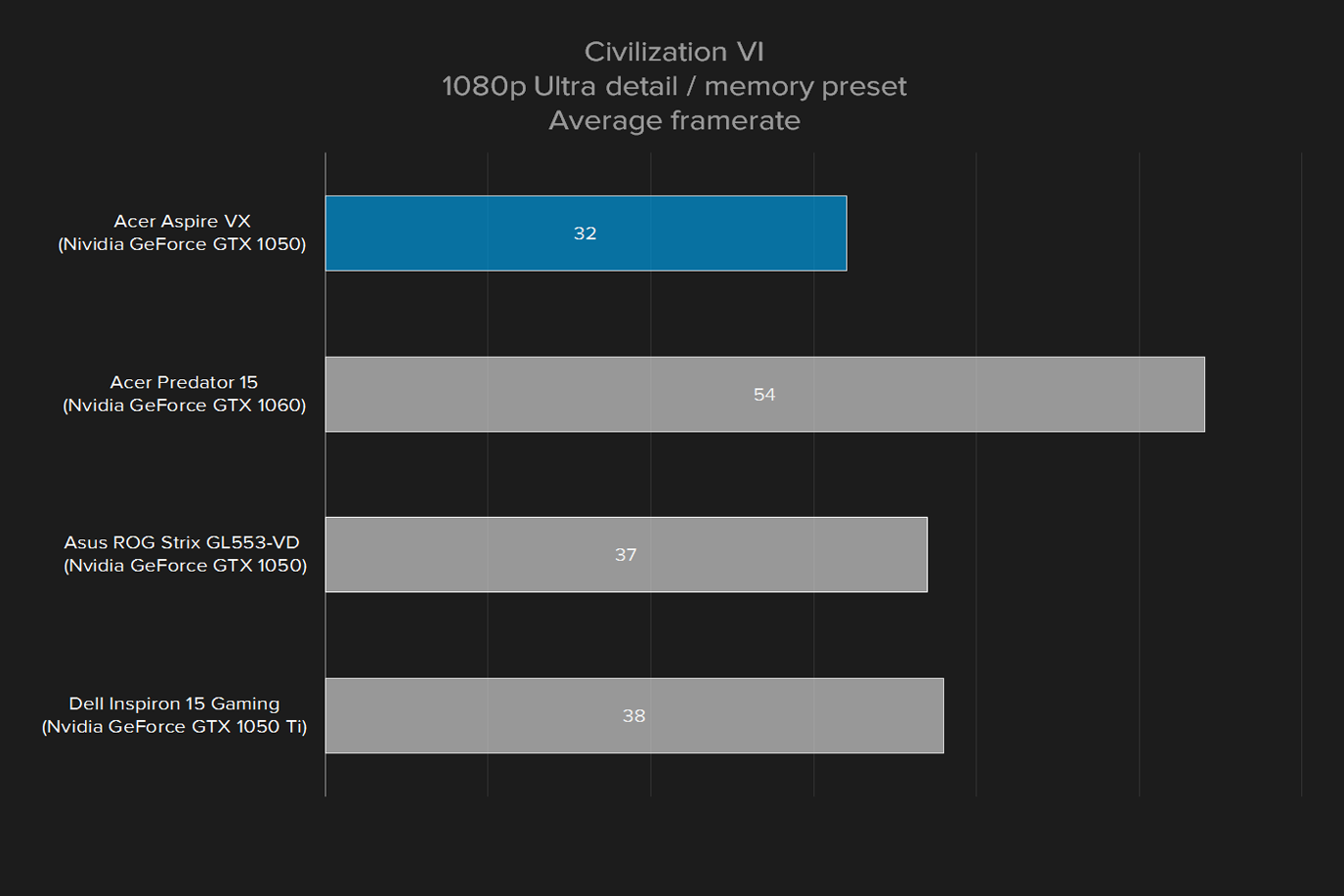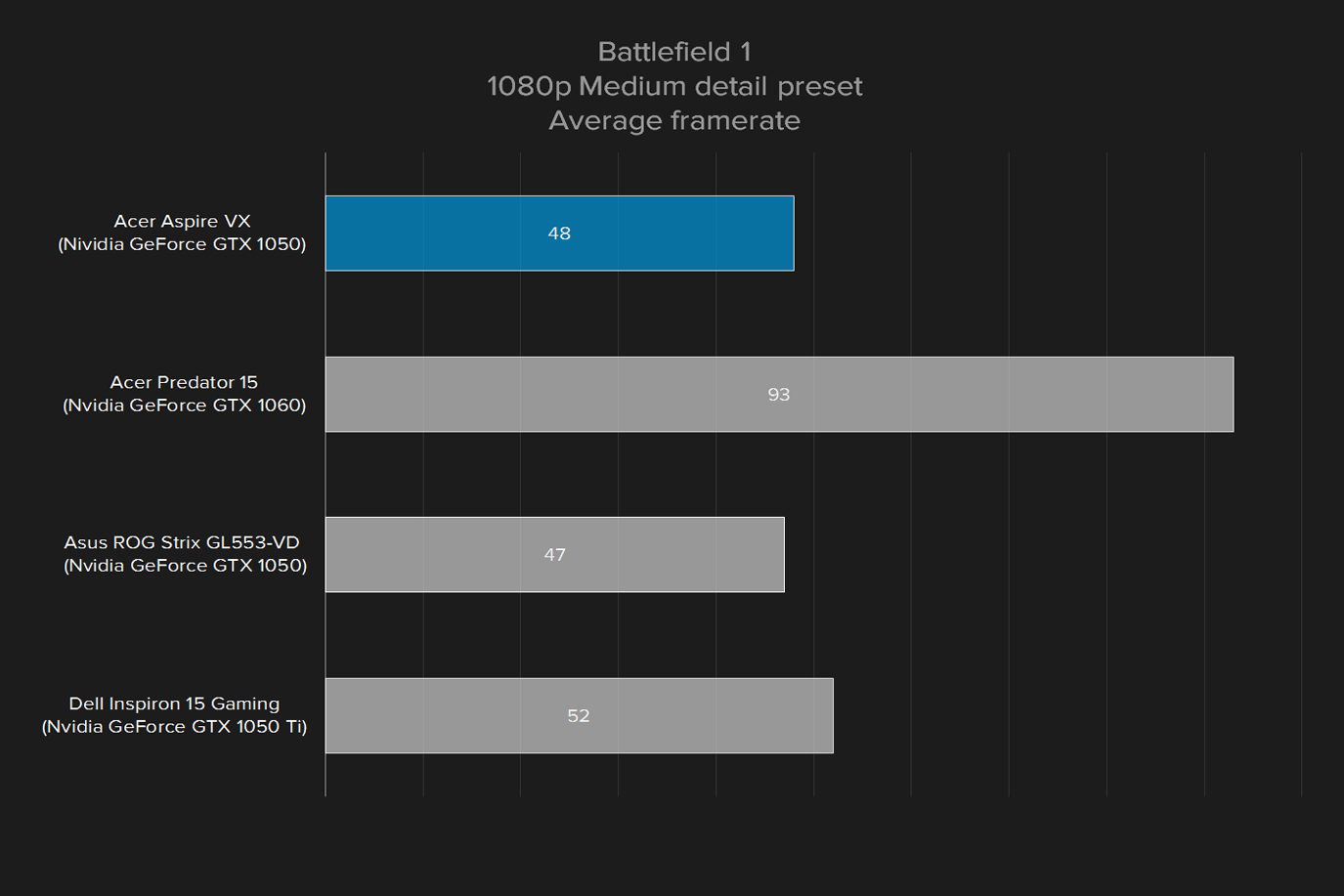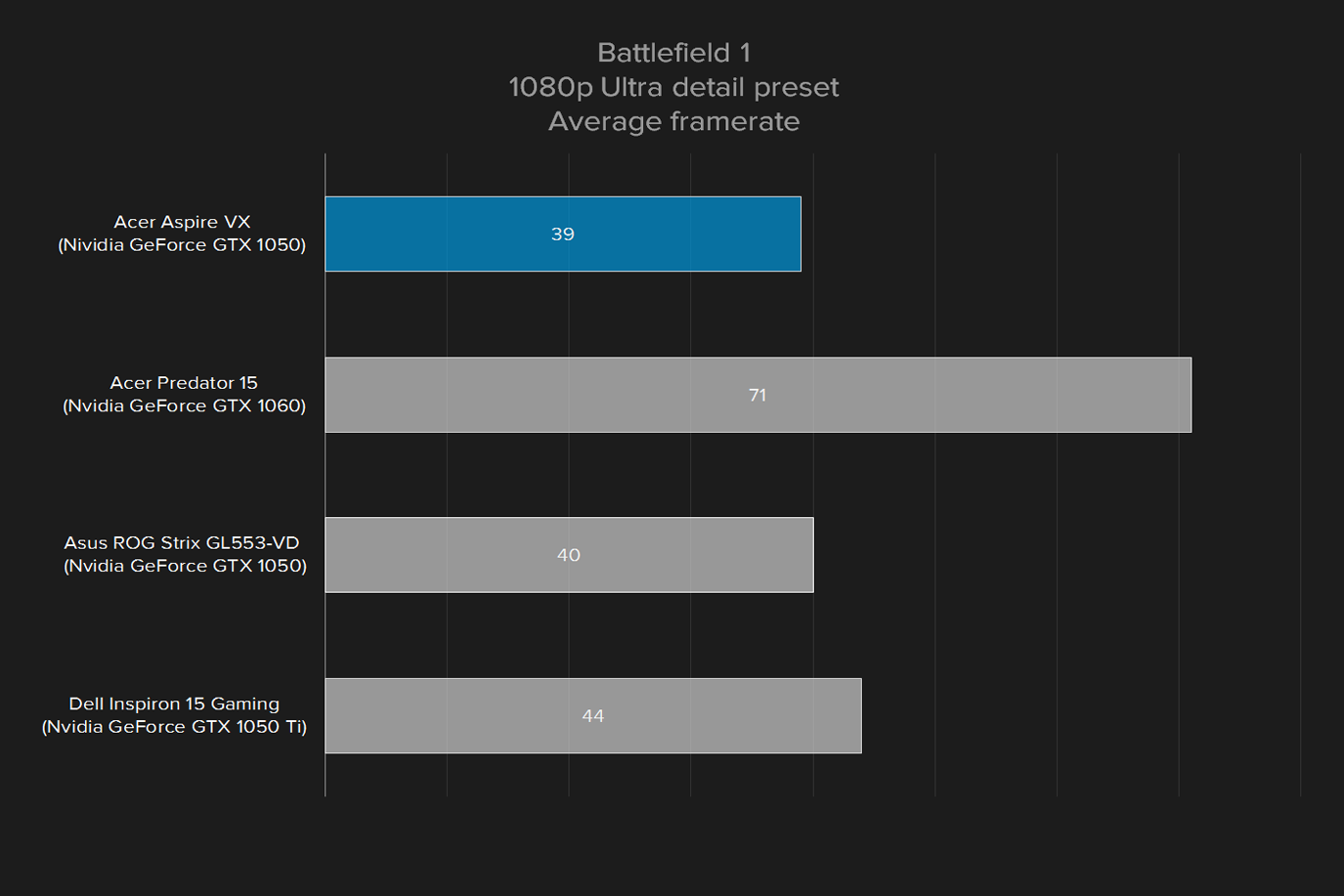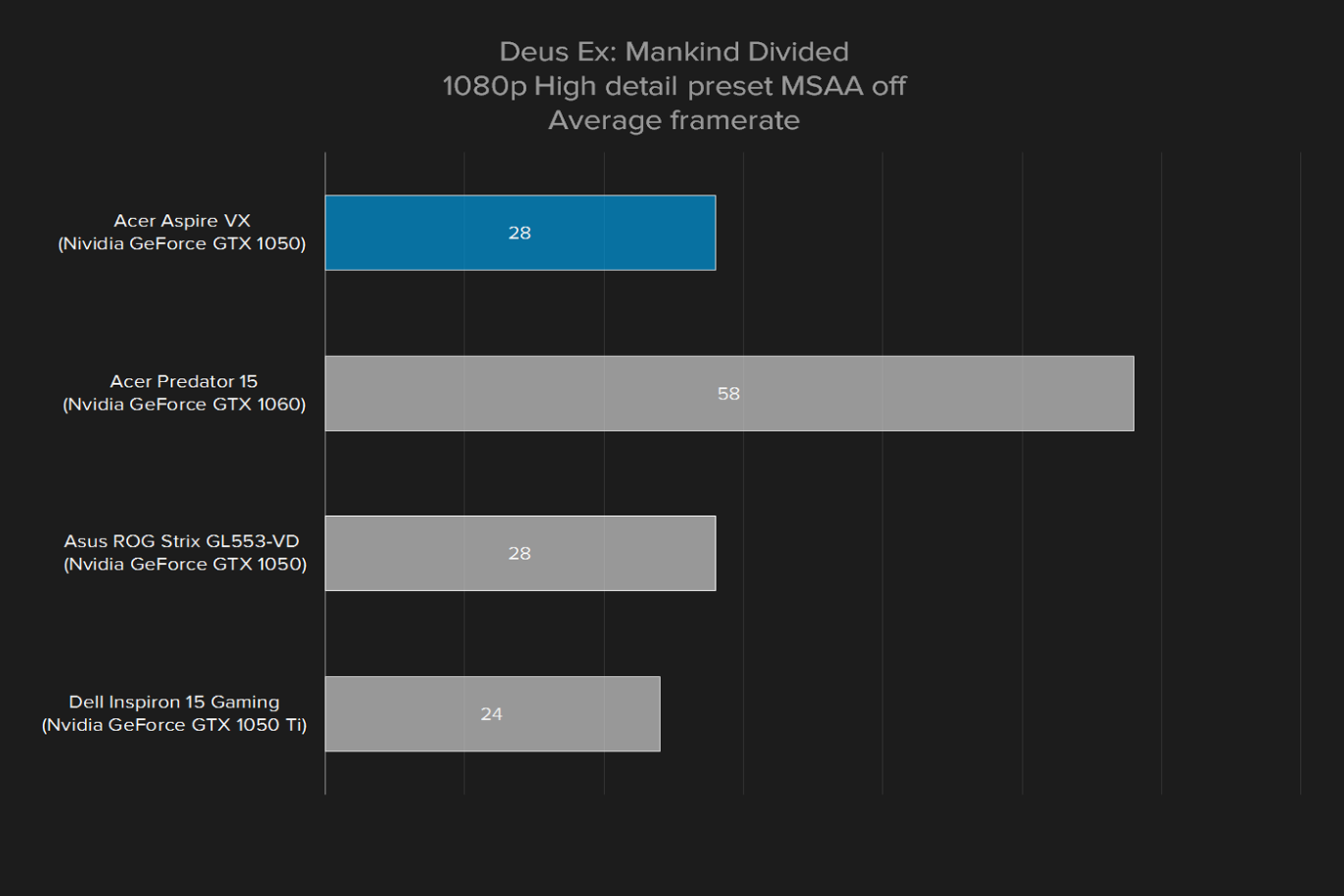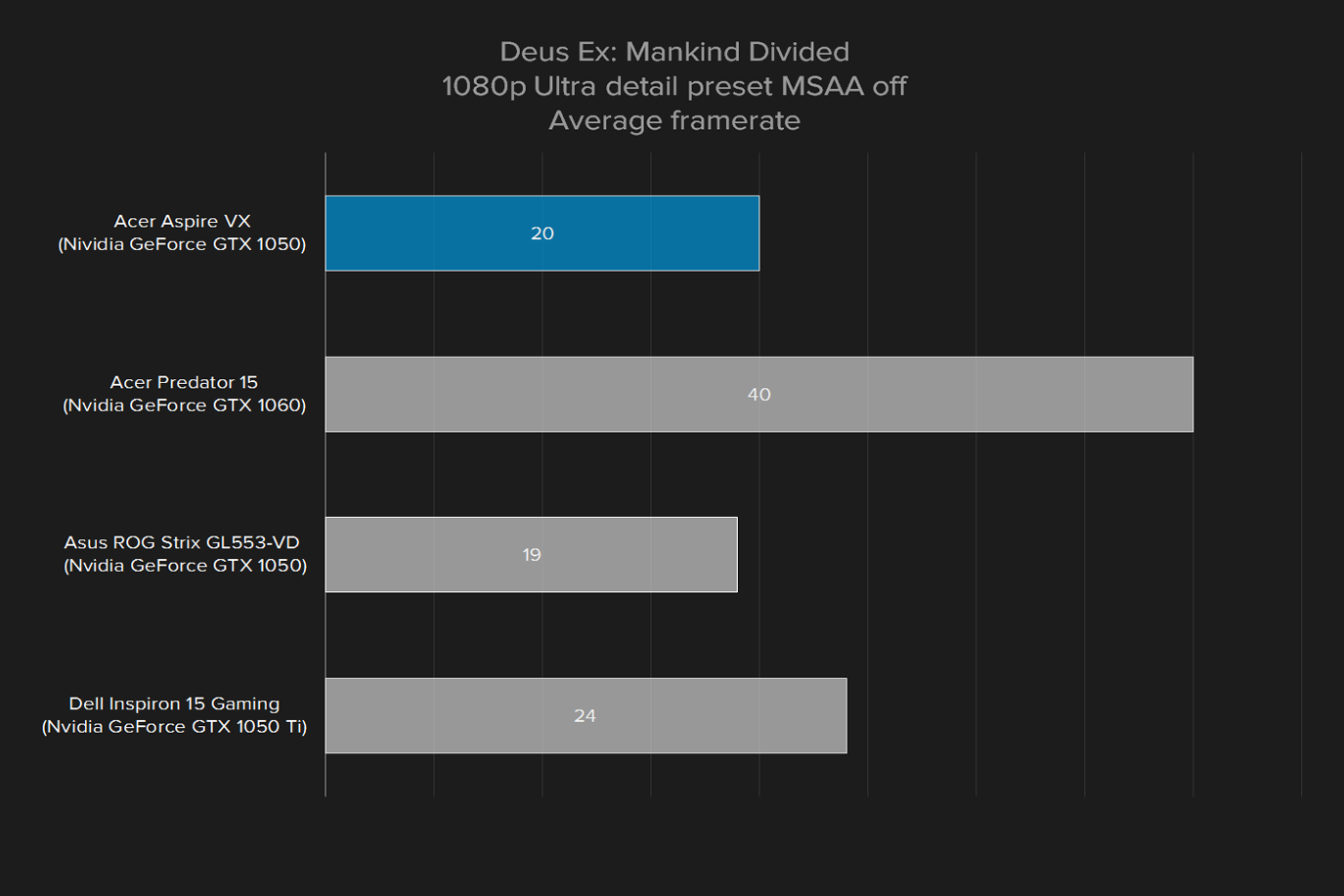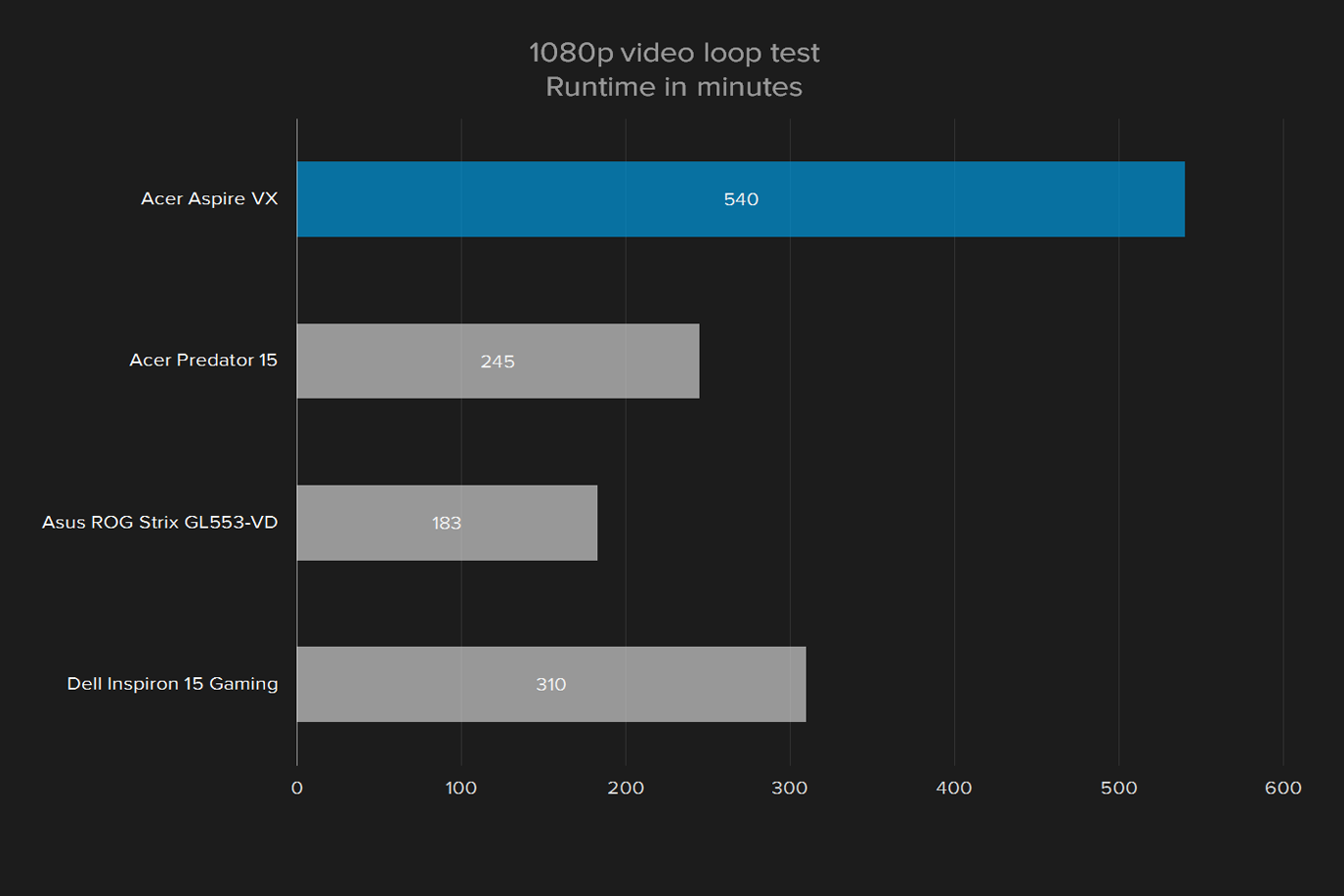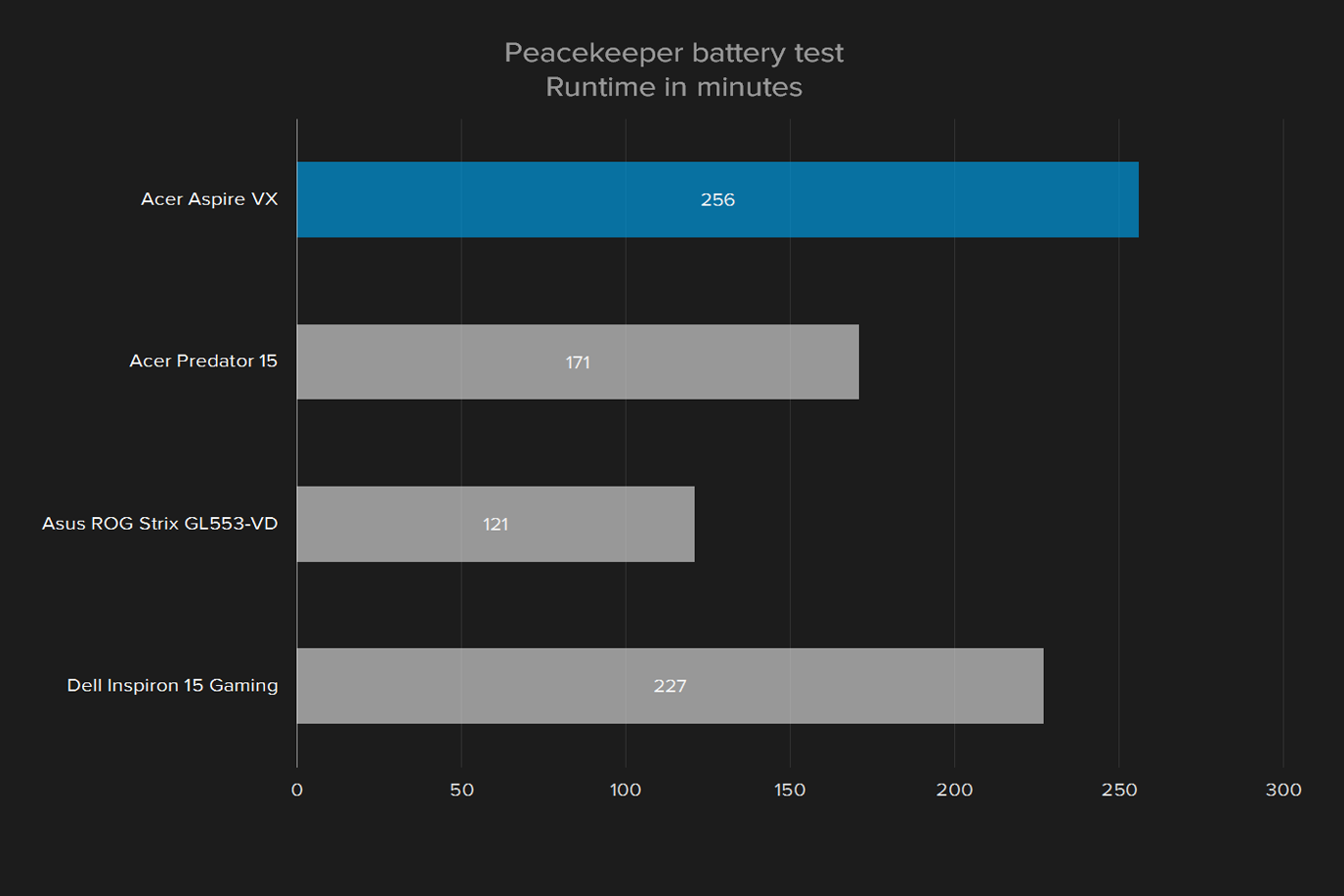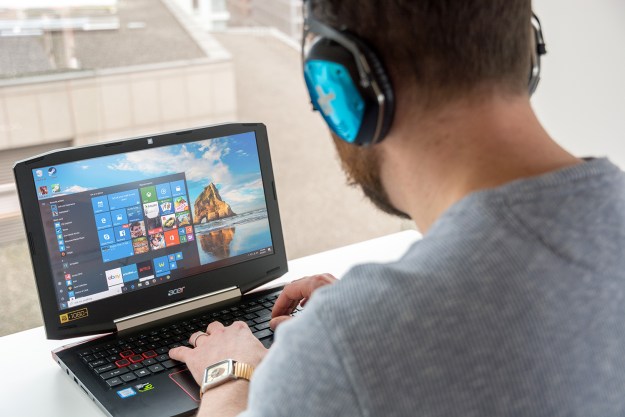
“The Aspire VX 15 is a budget laptop with all the style and grace of a 90’s boom box.”
- Inexpensive
- Good battery life
- Performs well in games, for the price
- Feels cheap
- Exceptionally poor display color gamut
- Unimpressive sound quality
- Too much bloatware
Budget gaming laptops are something of a contradiction. Gaming, by its very nature, requires powerful hardware, and budget laptops usually forego power for affordability. But over the past year, we’ve seen many gaming systems buck that trend, offering reasonable power for a reasonable price.
The Acer Aspire VX 15 appears to be one such budget gaming laptop. Starting at just $800, it undercuts some of the least expensive gaming notebooks. But did Acer cut too deep to hit that price point?
Oversized, and under-engineered
This is a budget laptop, and it feels like it. When you first lay your hands on the Acer Aspire VX 15, it’s easy to be impressed by the gently striated exterior — but once it opens up, the feeling fades quickly. The display is flanked on all sides by over an inch of cheap, hollow plastic.
Below, it’s supported by a flimsy plastic hinge that looks like it was spray-painted silver. The interior features another striated metal plate that wouldn’t be out of place on a 90’s era boom box.
This is a budget laptop, and it reminds you every time you touch it.
By comparison, the Dell Inspiron 15 Gaming, which is also a budget gaming system, features a slick and attractive design, and sturdy chassis. The Aspire VX 15 feels too large for its components — the excess plastic flanking the display on all sides makes the screen look smaller than it is.
The Aspire VX 15 is overlarge, weirdly shaped, and despite weighing in at 5.51 pounds, it doesn’t feel very substantial or sturdy. To be brutally honest, it feels like a knock-off version of the comparatively rock-solid (and more expensive) Acer Predator 15.
Portly, in a good way
Ports are more important than ever, since we’re in the middle of a transition period, and thankfully the Acer Aspire VX 15 won’t have you carrying around a bag of dongles and adapters to get through your day.
It features two USB Type-A ports on the right-hand side, alongside a USB Type-C port, an HDMI port, and an Ethernet jack. On the left-hand side there’s an SD card slot, power port, another USB Type-A port, and a headphone jack.
Essentially the Acer Aspire VX 15 has every port a user could need, and with the inclusion of a USB Type-C port its connectivity will serve you well even as manufacturers move away from the traditional USB Type-A ports.
Mushy keys, but a precise touchpad
Laptop keyboards are rarely noteworthy, but the Aspire VX 15’s keyboard is, and not for a good reason. The keys themselves feel a little flimsy, like you could pry them up with ease. Typing is satisfyingly clicky, without too much of the mushiness endemic to membrane keyboards. But there’s a problem, and it’s a problem you shouldn’t have to deal with: Some of the function keys don’t make sense.
Take brightness, for instance. The keys for turning up and down your brightness are ambiguously labeled, making it unclear which one turns up your brightness and which one turns it down.
Okay, to be fair, it’s not a huge deal. You get used to it very quickly, but you shouldn’t have to. Your function keys should be clear, unambiguous, and simple. They’re not new contrivances manufacturers are trying to figure out, they are solved problems, and this design error just indicates a lack of quality control that doesn’t bode well for the laptop.
Moving on to backlighting, the Aspire VX 15 comes with a backlit keyboard which reliably lights up your keys in the dark, but that’s about all it does. It’s not particularly bright, and it’s not customizable — no RGB lighting here – though it doesn’t suffer any unsightly light leakage, which is a plus. It’s just as good as any other keyboard backlight on a non-gaming system, more function than flair.
At least the trackpad doesn’t feature any such ambiguity. It’s right where it needs to be, and does just what it needs to do. Featuring support for Windows 10’s Precision Touchpad gestures, it’s smooth and accurate. It’s a little snappier than the trackpad on the Dell Inspiron 15 Gaming, but not quite as luxuriant as the trackpad on the Asus ROG Strix, which had a pleasant silky-smooth texture.
The display falls flat
Laptops are defined by their displays, but budget
Color gamut is usually the part most displays get right, or right enough that you wouldn’t even notice. Green looks green, blue looks blue, and so on. Looking at the numbers here, though, you can see that the Acer Aspire VX 15’s 1080p display panel manages a decent, middle-of-the-road contrast ratio, but the color gamut is way, way off. Capable of reproducing only 47 percent of the AdobeRGB spectrum, the Aspire VX 15’s display can handle a very narrow range of content.
Bright lime greens become dull, drab yellow-green, the color of dead grass in autumn. Everything, in fact, acquires a kind of yellow cast. This display would be great if you only ever needed to look at pictures of old phone books. It captures those colors very well.
Acer’s Predator 15 and the Asus ROG Strix GL553-VD both had displays that were acceptable, if not eye-catching, with decent contrast ratios and stock-standard color gamuts. Dark shadows might have been a bit gray, but colors were vibrant and recognizable. The same cannot be said of the Acer Aspire VX 15, which mangles colors until they’re unrecognizable, cruel parodies of their former selves.
Unsurprisingly, our color accuracy tests further described a display nearly incapable of accurately reproducing color. Professional-grade monitors, the kind used for photo editing, usually have average color error scores around .80, or .60, anything under 1.00 means that any errors the display has when it reproduces color are likely invisible to the human eye.
It’s not the worst average color error you’re likely to see on a laptop, but coupled with a disappointing color gamut, there’s not much this display gets right.
Headphones not required, but recommended
The Acer Aspire VX 15 features a set of built-in stereo speakers that aren’t likely to fill a room with lifelike sound, though they could be worse. For games, they get the job done. Voices are clear, background music is present, and sound effects don’t sound muddy or distorted. For music or movies, though, they’re a little less than adequate. The speakers strip out much of the definition and depth from music, and the same goes for film scores, which end up sounding lifeless.
That said, the speakers on the Aspire VX 15 are far from the worst we’ve ever heard on a laptop. Compared to the dry, brittle sound from the Acer Predator 15’s speakers, the Aspire VX 15 is appreciably better but not by much. They’re adequate, but after a while you’ll want to put your headphones back on.
A scrappy performer
Enough about the exterior — let’s check out what’s under the hood. The Acer Aspire VX 15 features a quad-core Intel Core i5-7300HQ processor clocked at 2.5GHz, which manages to hold its own against the CPUs inside similarly-priced and much more expensive
In everyday use the Core i5 is nimble, quick enough that you won’t notice any major performance issues but standard CPU benchmarks indicate it isn’t exactly a top-performer. It is a quad-core processor, but because it’s an i5 processor it doesn’t feature Hyper-Threading, which means those cores can each only handle a single instruction thread at a time.
By comparison, an Intel Core i7 with four cores can handle up to eight threads at once. It’s a difference that’s tough to notice in everyday internet browsing, while multi-tasking, the extra threads can give a Core i7 a performance boost over a Core i5. But this is a
Looking at the single-core Geekbench results, you can see how the Aspire VX 15’s Core i5 processor keeps up well with the Acer Predator and Asus ROG Strix, and their quad-core i7 processors. The Aspire VX 15’s a little slower than the Strix, but a little faster than the Acer Predator, with its 6th-generation Skylake processor.
Move on to the multi-core results, and the Aspire VX 15 doesn’t fare as well against its nearest competitors. The Predator and the Strix easily eclipse the Aspire VX 15’s Core i5 with their multi-core processing capabilities — in part because of their ability to use hyperthreading.
Looking what that means in everyday use, the Aspire VX 15 takes a little longer than the Strix and the Predator to encode a 420MB movie file to x.265. Without that extra horsepower, the Aspire VX 15’s Core i5 doesn’t quite perform as well as an i7 would but it does well enough to keep the competition from getting too far ahead.
Quick, but undersized
All right, the processor hangs on. But does the Aspire VX 15 eclipse its nearest cousins in any area? It does when it comes to hard disk speed, as the Aspire VX 15 runs circles around the much more expensive Asus ROG Strix, and is neck-and-neck with the Acer Predator 15.
With a 256GB SSD, the Aspire VX 15 doesn’t offer the most expansive storage, but it is quick. In our CrystalDiskMark tests, the Aspire VX 15’s SSD hit a read speed of 495 megabytes per second and a write speed of 378MB/s. It’s not the quickest SSD on the market, but it performs well against the Acer Predator 15’s SSD, edging it out in write speed and just about matching its read speed.
The Asus ROG Strix is left in the dust, with its super-slow mechanical hard disk, a throwback to a bygone era. Against the Strix, the Aspire VX 15 more than triples its read and write speeds with room to spare. But the Dell Inspiron 15 Gaming, which is around the same price as the Acer Aspire VX 15, pushes past the Aspire VX 15 in read and write speed with its own SSD.
All-in-all, the Aspire VX 15’s hard disk won’t slow you down, though it might keep you from installing too many games at once.
Keeping up with the GTX 1050 Ti
Before anything else, it’s a
In 3DMark, the Aspire VX 15 didn’t push past any of its nearest competitors, but it did manage to keep up with the Strix, and the Dell Inspiron 15 Gaming, both of which feature cards similar to its own GTX 1050. The Asus ROG Strix, which performed better on the 3DMark benchmarks than the Aspire VX 15, also features a GTX 1050, but its quicker processor and extra
The Dell Inspiron 15 Gaming features a GTX 1050 Ti, a quicker version of the 1050, and it easily outperformed the Strix and Aspire VX 15. Similarly, the Acer Predator 15 features a GTX 1060, a rock-solid mid-range card, and it outperforms all four of its nearest competitors in nearly every way.
In actual game performance, the distance between the Aspire VX 15 and the Acer Predator 15 is only about 15 frames per second on medium settings in Civilization VI. The gap widens significantly when switching to a more graphically intensive game like Battlefield 1.
On medium settings, the Aspire VX 15 hits an admirable 48 frames per second, which is about on par with the Dell Inspiron and the Asus ROG Strix. The Predator’s GTX 1060 almost doubles those figures though, hitting 93 frames per second on medium settings.
Moving up to Ultra, performance peels off a bit, leaving the Aspire VX 15 around 39 frames per second, with the Acer Predator 15 sitting comfortably in the low 70s.
Overall, the Aspire VX 15’s GTX 1050 performs admirably, and even manages to keep up with the more expensive Asus ROG Strix. It’s not going to play every game at high or maximum detail, but it performs as well can be expected for any budget
You might need a bigger bag
In a bag with a few other everyday items, though, the extra weight can add up quickly, making the whole package unwieldy in a backpack or messenger bag. So, this one’s probably not a good choice as a daily driver.
That said, the Aspire VX 15 has impressive battery life for a
On the Peacekeeper browser test, which is typically the most demanding battery test we run, the Acer Aspire VX 15 managed a little over four hours, easily pulling ahead of the Acer Predator 15 and Asus ROG Strix. The video loop test is typically the most forgiving benchmark we run, and on that test the Aspire VX 15 managed an impressive nine hours.
To be clear, that’s not nine hours of battery life, it’s nine hours of looping the same video with the brightness turned down to a little below 50 percent. It’s impressive though, especially for a
No, I don’t want to update
It’s 2017, we shouldn’t have to worry about bloatware. Sure there will be a couple branded utilities, and an app or two you don’t really want, but it’s rare to see a laptop with lots of extraneous programs pre-installed. The Acer Aspire VX 15 is, unfortunately, one such laptop.
Out of the box it comes chock-full of Acer branded utilities that run in the background, clutter up the system tray, and constantly ask you to update them or register your computer. It’s a minor headache, but it’s inexcusable these days.
Warranty information
The Acer Aspire VX 15 features a standard one-year warranty for any manufacturer defects, including parts and labor. It’s a little short, the Acer Predator 15 features a two-year warranty, but it’s one of the concessions you sometimes make with a budget laptop.
Our Take
It’s not the
Is there a better alternative?
Yes, there are better alternatives. The Dell Inspiron 15 Gaming has its own unique flaws, but with an Nvidia GeForce GTX 1050 Ti under the hood, it performs a bit better and has a much more attractive exterior design than the Aspire VX 15. The Dell’s display is rough, but so is this Acer’s. The Asus ROG Strix feels expensive for what it offers, but it does beat the Acer in performance and display quality by a fair margin.
How long will it last?
The Acer Aspire VX 15 doesn’t seem like a very well-built product. The interior components will likely age better than the exterior will. Nvidia’s GTX 1050 is a good bet, and the Intel Core i5 is a 7th-generation chip, the latest on the market. Chances are, your CPU and GPU will outlast that flimsy plastic-and-metal-plate exterior. Not to mention, the Aspire VX 15 already looks dated, even for a
Should you buy it?
The Acer Aspire VX 15 is not worth buying. Sure, it’s inexpensive compared to most
Editors' Recommendations
- Acer gets serious about 14-inch gaming laptops
- Acer’s new gaming laptop bring Nvidia RTX 40-series GPUs under $1,000
- ROG Flow X13 (2023) vs. ROG Zephyrus G14 (2023): compact gaming laptops
- This killer Black Friday deal on an RTX 3060 gaming laptop is still available
- The new Acer Swift 3 is an OLED laptop for just $900





